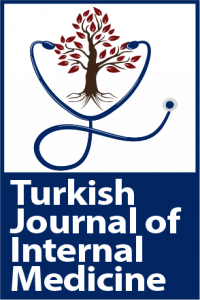Medication Errors and Potentially Inappropriate Medication Use in Elderly Patients Admitted to the General Internal Medicine Outpatient Clinic of a University Hospital
Medication Errors and Potentially Inappropriate Medication Use in Elderly Patients Admitted to the General Internal Medicine Outpatient Clinic of a University Hospital
Medication errors, Potentially inappropriate medication list Drug-related side effects and adverse reactions, Polypharmacy, Aged,
___
- McLean AJ, Le Couteur DG. Aging biology and geriatric clinical pharmacology. Pharmacol Rev. 2004 Jun;56(2):163-84. doi: 10.1124/pr.56.2.4.
- Hanlon JT, Lindblad CI, Hajjar ER, McCarthy TC. Update on drug related problems in the elderly. Am J Geriatr Pharmacother. 2003 Sep;1(1):38-43. doi: 10.1016/s1543-5946(03)80014-4.
- Mira JJ, Orozco-Beltran D, Perez-Jover V, Martínez-Jimeno L, Gil-Guillén VF, Carratala-Munuera C, Sánchez-Molla M, Pertusa-Martínez S, Asencio-Aznar A. Physician patient communication failure facilitates medication errors in older polymedicated patients with multiple comorbidities. Fam Pract. 2013 Feb;30(1):56-63. doi: 10.1093/fampra/cms046.
- Marcum ZA, Gellad WF. Medication adherence to multi-drug regimens. Clin Geriatr Med. 2012 May;28(2):287-300. doi: 10.1016/j.cger.2012.01.008.
- Ferner RE, Aronson JK. Clarification of terminology in medication errors: definitions and classification. Drug Saf 2006;29(11):1011-22. doi: 10.2165/00002018-200629110-00001.
- Britten N. Medication errors: The role of the patients. Br J Clin Pharmacol. 2009 Jun;67(6):646-50. doi: 10.1111/j.1365- 2125.2009.03421.x.
- American Geriatrics Society 2015 Beers Criteria Update Expert Panel. American Geriatrics Society 2015 Updated Beers Criteria for Potentially Inappropriate Medication Use in Older Adults. J Am Geriatr Soc. 2015 Nov;63(11):2227-46. doi: 10.1111/jgs.13702.
- Gallagher P, Ryan C, Byrne S, Kennedy J, O’Mahony D. STOPP (Screening Tool of Older Person’s Prescriptions) and START (Screening Tool to Alert doctors to Right Treatment). Consensus validation. Int J Clin Pharmacol Ther. 2008 Feb;46(2):72-83. doi: 10.5414/cpp46072.
- Nobili A, Franchi C, Pasina L, Tettamanti M, Baviera M, Monesi L, Roncaglioni C, Riva E, Lucca U, Bortolotti A, Fortino I, Merlino L. Drug utilization and polypharmacy in an Italian elderly population: the EPIFARM-Elderly Project. Pharmacoepidemiol Drug Saf. 2011 May;20(5):488-96. doi: 10.1002/pds.2108.
- Kaufmann DW, Keelly JP, Rosenberg L, Anderson TE, Mitchell AA. Recent pattern of medication use in the ambulatory adult population of the United States. The Slone Survey. JAMA. 2002 Jan 16;287(3):337-44. doi: 10.1001/jama.287.3.337.
- Gocer S, Gunay O, Polat T, Ulutabanca RO, Sonkaya ZI. Polypharmacy and associated factors in people living in a nursing home in Kayseri Turkey. Med Sci. 2017;6(4):646-52. doi: 10.5455/medscience.2017.06.8633.
- Junius-Walker U, Theile G, Hummers-Pradier E. Prevalence and predictors of polypharmacy among older primary care patients in Germany. Fam Pract. 2007 Feb;24(1):14-9. doi: 10.1093/fampra/cml067.
- Bahat G, Tufan F, Bahat Z, Tufan A, Aydin Y, Akpinar TS, Nadir S, Erten N, Karan MA. Comorbidities, polypharmacy, functionality and nutritional status in Turkish community- dwelling female elderly. Aging Clin Exp Res. 2014 Jun;26(3):255-9. doi: 10.1007/s40520-014-0229-8.
- Banerjee A, Mbamalu D, Ebrahimi S, Khan AA, Chan TF. The prevalence of polypharmacy in elderly attenders to an emergency department - a problem with a need for an effective solution. Int J Emerg Med. 2011 Jun 2;4(1):22. doi: 10.1186/1865- 1380-4-22.
- Viktil KK, Blix HS, Moger TA, Reikvam A. Polypharmacy as commonly defined is an indicator of limited value in the assessment of drug-related problems. Br J Clin Pharmacol. 2007 Feb;63(2):187-95. doi: 10.1111/j.1365-2125.2006.02744.x.
- Nobili A, Licata G, Salerno F, Pasina L, Tettamanti M, Franchi C, De Vittorio L, Marengoni A, Corrao S, Iorio A, Marcucci M, Mannucci PM. Polypharmacy, length of hospital stay, and in-hospital mortality among elderly patients in internal medicine wards. The REPOSI Study. Eur J Clin Pharmacol. 2011 May;67(5):507-19. doi: 10.1007/s00228-010-0977-0.
- Bulatova N, Elayeh E, Abdullah S, Halaseh L, Abuloha S, Raqeeq MA, Aldaghlise D, Alrbeihat G. Assessment of inappropriate medication use in Jordanian elderly hospitalized patients using 2015 Beers criteria. Turkish Journal of Geriatrics. 2019;22(3):258-68. doi: 10.31086/tjgeri.2019.101.
- Novaes PH, da Cruz DT, Lucchetti ALG, Leite ICG, Lucchett G. The ‘‘iatrogenic triad’’: polypharmacy, drug-drug interactions, and potentially inappropriate medications in older adults. Int J Clin Pharm. 2017 Aug;39(4):818-25. doi: 10.1007/s11096-017- 0470-2.
- Bahat G, Bay I, Tufan A, Tufan F, Kilic C, Karan MA. Prevalence of potentially inappropriate prescribing among older adults: A comparison of the Beers 2012 and Screening Tool of Older Person’s Prescriptions criteria version 2. Geriatr Gerontol Int. 2017 Sep;17(9):1245-51. doi: 10.1111/ggi.12850.
- Kaplan Ç, Bilge U, Acar N, Ünlüoğlu İ. Determination of polypharmacy and inapproprıate drug use in patients aged over 65 years who presented to the emergency department. Turkish Journal of Geriatrics. 2019;22(3):287-94. doi: 10.31086/ tjgeri.2019.104.
- ZhangX,ZhouS,PanK,ZhouX,LiX,ZhouY,CuiY,Liu X. Potentially inappropriate medications in hospitalized older patients: a cross-sectional study using the Beers 2015 criteria versus the 2012 criteria. Clin Interv Aging. 2017 Oct 12;12:1697- 1703. doi: 10.2147/CIA.S146009.
- Chun JC, Appel SJ, Simmons S. 2015 Beers criteria medication review in assisted living facilities. J Am Assoc Nurse Pract. 2018 Nov;30(11):648-654. doi: 10.1097/JXX.0000000000000082.
- Chiapella LC, Menna JM, Marzi M, Mamprin ME. Prevalence of potentially inappropriate medications in older adults in Argentina using Beers criteria and the IFAsPIAM List. Int J Clin Pharm. 2019 Aug;41(4):913-9. doi: 10.1007/s11096-019- 00858-8.
- SalbuRL,FeuerJ.Acloserlookatthe2015BeersCriteria.JPharm Pract. 2017 Aug;30(4):419-24. doi: 10.1177/0897190016663072.
- Gray SL, Mahoney JE, Blough DK. Medication adherence in elderly patients receiving home health services following hospital discharge. Ann Pharmacother. 2001 May;35(5):539-45. doi: 10.1345/aph.10295.
- Başlangıç: 2019
- Yayıncı: Nizameddin KOCA
Radiotherapy could increase the efficacy of immunotherapy in non-small cell lung cancer
Birol OCAK, Süreyya SARIHAN, Ahmet Bilgehan ŞAHİN, Bahar DAKİKİ, Burcu CANER, Kemal GÜLŞEN, Özgür TANRIVERDİ, Adem DELİGÖNÜL, Erdem ÇUBUKÇU, Türkkan EVRENSEL
Pembrolizumab Induced Hypothyroidism: A Case Report
Sidelya Ecem YİĞİT, İffet Beril GÖKMEN, Yıldız OKUTURLAR
Post-transplant Lymphoproliferative Disorder Following Kidney Transplantation,
Thrombocytopenic Thrombotic Pupura Presenting with Neurological Symptoms : A Case Report
Yağmur ÇAKIR, Bedrettin ORHAN, Vildan OZKOCAMAN, Fahir ÖZKALEMKAŞ
Ground Glass Appearance During the Pandemic Period: Everolimus Induced Interstitial Pneumonia
Sidelya Ecem YİĞİT, İffet Beril GÖKMEN, Yıldız OKUTURLAR
Ersin ELGİN, Mehmet SEZEN, Abdulmecit YİLDİZ, Ayşegül ORUÇ, Mehmet Çağatay ÇİÇEK, Kadir Ömür GÜNSEVEN, Kerem SELİMOĞLU, Rafet OFLAZ, Alparslan ERSOY
Ercan PESEN, Celaleddin DEMİRCAN, Deniz SIĞIRLI
Tuba GÜLLÜ KOCA, Fahir ÖZKALEMKAŞ, Vildan OZKOCAMAN, Tuba ERSAL, Şeyma ESENBUĞA
